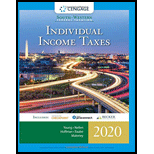
Individual Income Taxes
43rd Edition
ISBN: 9780357109731
Author: Hoffman
Publisher: CENGAGE LEARNING - CONSIGNMENT
expand_more
expand_more
format_list_bulleted
Question
Chapter 19, Problem 30P
To determine
Compute the non-forfeitable percentage for each of the participants depending upon the years of service completed.
Expert Solution & Answer
Want to see the full answer?
Check out a sample textbook solution
Students have asked these similar questions
Can you explain the steps for solving this General accounting question accurately?
General Accounting
I need correct option
Chapter 19 Solutions
Individual Income Taxes
Ch. 19 - Prob. 1DQCh. 19 - Prob. 2DQCh. 19 - Prob. 3DQCh. 19 - Prob. 4DQCh. 19 - Prob. 5DQCh. 19 - Prob. 6DQCh. 19 - Prob. 7DQCh. 19 - Prob. 8DQCh. 19 - Prob. 9DQCh. 19 - Prob. 10DQ
Ch. 19 - Prob. 11DQCh. 19 - Prob. 12DQCh. 19 - Prob. 13DQCh. 19 - Prob. 14CECh. 19 - Prob. 15CECh. 19 - Prob. 16CECh. 19 - Prob. 17CECh. 19 - Zack, a sole proprietor, has earned income of...Ch. 19 - Prob. 19CECh. 19 - Prob. 20CECh. 19 - Prob. 21CECh. 19 - Prob. 22CECh. 19 - Prob. 23CECh. 19 - Prob. 24CECh. 19 - Prob. 25CECh. 19 - On April 5, 2017, Gustavo was granted an NQSO for...Ch. 19 - Prob. 27PCh. 19 - Prob. 28PCh. 19 - Prob. 29PCh. 19 - Prob. 30PCh. 19 - Prob. 31PCh. 19 - Prob. 32PCh. 19 - Prob. 33PCh. 19 - Prob. 34PCh. 19 - In 2019, Magenta Corporation paid compensation of...Ch. 19 - Prob. 36PCh. 19 - Prob. 37PCh. 19 - Prob. 38PCh. 19 - Prob. 39PCh. 19 - Prob. 40PCh. 19 - Prob. 41PCh. 19 - Prob. 42PCh. 19 - Prob. 43PCh. 19 - Prob. 44PCh. 19 - Carri and Dane, ages 34 and 32, respectively, have...Ch. 19 - Prob. 46PCh. 19 - Prob. 47PCh. 19 - Prob. 48PCh. 19 - Prob. 49PCh. 19 - Prob. 50PCh. 19 - Prob. 51PCh. 19 - Prob. 52PCh. 19 - Prob. 53PCh. 19 - Prob. 54PCh. 19 - Prob. 55PCh. 19 - Prob. 56PCh. 19 - Prob. 57PCh. 19 - Prob. 1RPCh. 19 - Prob. 2RPCh. 19 - Prob. 3RPCh. 19 - Prob. 6RPCh. 19 - Prob. 8RPCh. 19 - Prob. 1CPACh. 19 - Ryan is 39 years old and works as a real estate...Ch. 19 - Prob. 3CPACh. 19 - Prob. 4CPA
Knowledge Booster
Learn more about
Need a deep-dive on the concept behind this application? Look no further. Learn more about this topic, accounting and related others by exploring similar questions and additional content below.Similar questions
arrow_back_ios
SEE MORE QUESTIONS
arrow_forward_ios
Recommended textbooks for you
 Individual Income TaxesAccountingISBN:9780357109731Author:HoffmanPublisher:CENGAGE LEARNING - CONSIGNMENT
Individual Income TaxesAccountingISBN:9780357109731Author:HoffmanPublisher:CENGAGE LEARNING - CONSIGNMENT Intermediate Accounting: Reporting And AnalysisAccountingISBN:9781337788281Author:James M. Wahlen, Jefferson P. Jones, Donald PagachPublisher:Cengage Learning
Intermediate Accounting: Reporting And AnalysisAccountingISBN:9781337788281Author:James M. Wahlen, Jefferson P. Jones, Donald PagachPublisher:Cengage Learning

Individual Income Taxes
Accounting
ISBN:9780357109731
Author:Hoffman
Publisher:CENGAGE LEARNING - CONSIGNMENT



Intermediate Accounting: Reporting And Analysis
Accounting
ISBN:9781337788281
Author:James M. Wahlen, Jefferson P. Jones, Donald Pagach
Publisher:Cengage Learning

How to Calculate your Income Tax? Step-by-Step Guide for Income Tax Calculation; Author: ETMONEY;https://www.youtube.com/watch?v=QdJKpSXCYmQ;License: Standard YouTube License, CC-BY
How to Calculate Federal Income Tax; Author: Edspira;https://www.youtube.com/watch?v=2LrvRqOEYk8;License: Standard Youtube License